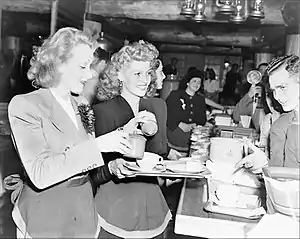Hollywood Canteen
The Hollywood Canteen operated at 1451 Cahuenga Boulevard in the Los Angeles, California, neighborhood of Hollywood between October 3, 1942, and November 22, 1945 (Thanksgiving Day), as a club offering food, dancing and entertainment for servicemen, who were usually on their way overseas. Even though the majority of visitors were US servicemen, the canteen was open to servicemen of allied countries as well as women in all branches of service. A serviceman's ticket for admission was his uniform and everything at the canteen was free of charge.

The East Coast counterpart was the New York City–based Stage Door Canteen, which featured Broadway stars and was also celebrated in a film, Stage Door Canteen.[1]
History
In 1942, Bette Davis, along with John Garfield, were among the members of the Hollywood Victory Committee who helped establish the Hollywood Canteen.[2] The various guilds and unions of the entertainment industry donated the labor and money for the building renovations. The canteen was operated and staffed completely by volunteers from the entertainment industry and Davis served as President throughout the war.[3][4] By the time the canteen opened its doors, over three thousand stars, players, directors, producers, grips, dancers, musicians, singers, writers, technicians, wardrobe attendants, hair stylists, agents, stand-ins, publicists, secretaries, and allied craftsmen of radio and screen had registered as volunteers.
Stars volunteered to wait on tables, cook in the kitchen, and clean up. One of the highlights for a serviceman was to dance with one of the many female celebrities volunteering at the canteen. The other highlight was the entertainment provided by some of Hollywood's most popular stars, ranging from radio stars to big bands to novelty acts. On September 15, 1943, the one millionth guest walked through the door of the Hollywood Canteen. The lucky soldier, Sergeant Carl Bell, received a kiss from Betty Grable and was escorted in by Marlene Dietrich. Another lucky soldier, Herman Harney, got a chance to dance with Rosemary Lane of the singing Lane Sisters.
A Hall of Honor at the Hollywood Canteen had a wall of photos which honored the film actors who served in the military.
By 1944, the canteen had become so popular that Warner Bros. made a movie titled Hollywood Canteen. Starring Joan Leslie and Robert Hutton, the film had scores of stars, many of whom had volunteered at the real canteen, playing themselves. It was directed by Delmer Daves, who also wrote the screenplay. Warner Bros. donated 40% of proceeds from the film to both the Hollywood Canteen and the Stage Door Canteen in New York.[5]
At the time the canteen closed its doors, it had been host to almost three million servicemen.
Maria Riva, Dietrich's daughter, recalled an anecdote where Marlene Dietrich decided to wash dishes and was joined by Hedy Lamarr. Bette Davis quipped "get those two krauts out of the kitchen!"[6]
References to the Hollywood Canteen often erroneously give it the address of The Hollywood Guild and Canteen, which was located at 1284 North Crescent Heights Boulevard in a home owned by the estate of actor Dustin Farnum. It was here that Anne "Mom" Lehr provided meals and bunk beds for servicemen until the end of the Second World War. When the home was razed in 1948, news articles failed to distinguish between the two "Hollywood Canteens", leading to a lasting confusion.[7]
The building where the canteen was located no longer exists; a parking garage and a building operated by CNN are now located on the site, which is just south of Sunset Boulevard.
Volunteers
Noted celebrities who donated their services at the Hollywood Canteen are listed.
See also
References
- Aaker, Everett (2013). George Raft: The Films. Jefferson, North Carolina: McFarland & Company. p. 106. ISBN 978-0-7864-6646-7.
- Harrison, Scott (March 6, 2017). "From the Archives: Entertaining the troops at Hollywood Canteen". Los Angeles Times. Retrieved August 6, 2023.
- Mitchell, Lisa; Torrence, Bruce (2013). The Hollywood Canteen: Where the Greatest Generation Danced with the Most Beautiful Girls in the World. BearManor Media. ISBN 1593934092.
- Sikov, Ed (2007). Dark Victory: The Life of Bette Davis. New York: Henry Holt and Company. pp. 210–211. ISBN 0805088636.
- The American Film Institute Catalog of Motion Pictures Produced in the United States: Feature Films, 1941-1950. University of California Press. 1999. p. 1071. ISBN 9780520215214.
- Marlene Dietrich: Her Own Song
- "Famous Hollywood Landmark Razed". St. Petersburg Times. Vol. 65, no. 93. Associated Press. October 26, 1948. p. 2. Retrieved June 29, 2015.